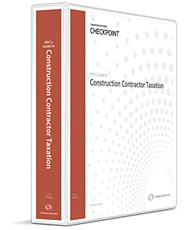We're available Monday to Friday from 8 a.m. to 6 p.m. eastern time.
Need help right now? Call 1-800-431-9025.


PPC's Guide to Construction Contractor Taxation provides comprehensive “how to” guidance on the issues surrounding construction contractors. The guidance is designed to provide practical, thorough, and up-to-date guidance on the unique tax issues faced by contractors. Although IRS regulations and rulings are a complex maze in the area of construction contractors, this Guide's unique approach organizes and summarizes tax data in a manner that allows practitioners and industry accountants to easily understand basic concepts and retrieve relevant information without investing endless time in research.
Rather than just telling you what the rules and regulations say, this Guide includes over 170 real-life scenarios and examples that reduce the technical language of official pronouncements to easy-to-understand advice and procedures. The case studies and examples help you address almost every situation you may encounter related to construction contractors, including the requirements and calculations for some of the more difficult construction-related tax areas, such as calculating the percentage of completion, look-back interest, and alternative minimum tax. This Guide also contains numerous forms and checklists designed to assist you in preparing tax returns for construction contractors as well as making the difficult calculations and decisions that contractors constantly face.
The following are some of the features of PPC's Guide to Construction Contractor Taxation:
Statutory Rules and Regulations. This Guide answers all of your questions on the statutory rules and regulations relating to large contractors, small contractors, and home construction contracts, as well as the tax reporting and compliance issues specific to subcontractors. Included in the discussions are issues common to construction contractors such as mid-contract changes in taxpayers and changing from a small to a large contractor.
Legislative Update. IRS rules and regulations are constantly changing. This Guide contains updated guidance for changes in tax law affecting construction contractors.
Industry Trends. Because the construction contractor industry is affected by changes in the economy and other factors, this Guide provides an overview of current trends in the industry as well as considerations for the contractor to think about in light of these trends.
Issues Challenged by the IRS. The IRS periodically challenges taxpayer treatment of certain transactions. Some of these “hot” topics are specific to construction contractors, while others could affect taxpayers in all industries. This Guide contains discussions on some of these “hot” topics to help you address areas the IRS is currently focusing on during its examinations.
New Business Entities. Before a contractor can determine the appropriate form of entity, several tax and nontax issues need to be addressed. This Guide contains discussions and practice aids that can assist you in determining the most appropriate form of entity for a contractor's business.
Changes in Accounting Methods. Changes in accounting methods are a common occurrence with construction contractors. This Guide contains discussions on accounting method changes that will help you in addressing all of the required procedures when a contractor is electing or changing an accounting method. The Guide also includes an illustration of a completed Form 3115, “Application for Change in Accounting Method,” using the current version of that federal tax form.
Depreciation. The typical contractor spends significant sums of money each year to purchase and maintain the equipment necessary to complete its contracts. This Guide includes a discussion on vehicle depreciation and an appendix containing guidelines for assets placed in service after December 31, 1998.
Contact Your Account Manager to learn more about our Checkpoint online solutions